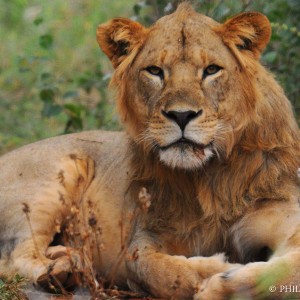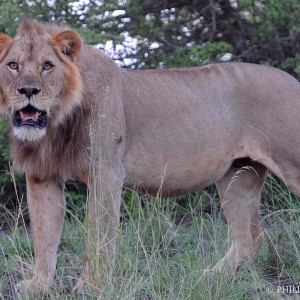Sikiria

For lions, each observation we get of them is a piece of a puzzle – we need to come together and share these pieces to see the whole picture and to effectively conserve the remaining lion populations. Help us save more lions; help us “Make the LINC.” It was late in the afternoon when the report came in – Lion Guardian Kamunu had picked up Selenkay’s signal on his way home from his regional coordinator duties that day. It was a report, we had to follow up on as Selenkay, one our most notorious livestock killers, and her cubs are the future of lions in Eselenkei Group Ranch and we needed to make sure she was doing well. For several months now, we had been searching for her to no avail. We desperately wanted to see her cubs in order to get proper whisker spot ID’s as well as confirm their sexes. Dropping everything, we hurried out of camp with no clue of the sights awaiting us. As we neared the GPS point that Kamunu had sent us, we caught her signal loud and clear. We started to track the signal and before we knew it were rewarded with the most wondrous sight – there in a little clearing, were Selenkay, her now-grown daughters from 2009, Nenkii, Meoshi, and eight fat little cubs, all feasting on a zebra kill. For the next two and half hours, we sat and watched as Selenkay and her pride feasted and played. They were in such great spirits at being together after a fairly long period of time – they pounced, climbed trees and pushed each other over. It was the most heartwarming sight we had seen in a long time. And most importantly, we managed to capture great identification shots of the eight new cubs (Selenkay and Meoshi have four cubs each).
It was late in the afternoon when the report came in – Lion Guardian Kamunu had picked up Selenkay’s signal on his way home from his regional coordinator duties that day. It was a report, we had to follow up on as Selenkay, one our most notorious livestock killers, and her cubs are the future of lions in Eselenkei Group Ranch and we needed to make sure she was doing well. For several months now, we had been searching for her to no avail. We desperately wanted to see her cubs in order to get proper whisker spot ID’s as well as confirm their sexes. Dropping everything, we hurried out of camp with no clue of the sights awaiting us. As we neared the GPS point that Kamunu had sent us, we caught her signal loud and clear. We started to track the signal and before we knew it were rewarded with the most wondrous sight – there in a little clearing, were Selenkay, her now-grown daughters from 2009, Nenkii, Meoshi, and eight fat little cubs, all feasting on a zebra kill. For the next two and half hours, we sat and watched as Selenkay and her pride feasted and played. They were in such great spirits at being together after a fairly long period of time – they pounced, climbed trees and pushed each other over. It was the most heartwarming sight we had seen in a long time. And most importantly, we managed to capture great identification shots of the eight new cubs (Selenkay and Meoshi have four cubs each).
It was an extraordinary evening indeed – observing a pride of females and cubs, all that we have known and watched grow since they themselves were cubs, in a non-protected area is a special feeling. This is something that has been made possible through the concerted efforts of conservation organizations and the tolerance of communities in the area. You, our supporters, are also a great reason for this success – without your help we would not be able to conserve lions and bring you these wonderful reports from the field. We thank you again from the bottom of our hearts for your support.
If you want to keep supporting our efforts in the field, an easy way to do so is by adopting a cub. You could be the adoptee of one of these lovely eight cubs for just $250. Sign up today and help keep Selenkay, Nenkii, Meoshi and their eight cubs alive and out of trouble!Upon further analysis of his movement patterns, we discovered that he had passed through 32 Lion Guardians zones, three counties, several Maasai sections and two countries. To our knowledge, he is the only documented lion in Kenya and possibly East Africa with such a large range, almost comparable to the lions of the Namib Desert. Reasons fronted in support of his exceptional movement patterns range from their relative young age to the search for females, prey and territory.
When Sikiria came to Mbirikani Group Ranch for the second time in 2011, he had matured. He and Oyayai behaved well and they found a perfect place to settle in: Oltiasika. An area at the foot of Chyulu hills that is ideal lion habitat, full of prey, water, females, and one of the best places for lions to hide-in, the volcanic lava flows from the Chyulu Hills. Sikiria had always been a problem lion but our Lion Guardians in conjunction with other stakeholders within the Amboseli ecosystem, such as Big Life game scouts and KWS rangers, were able to protect him until two years ago. Sadly, he was killed in retaliation for livestock killed in an area outside our jurisdiction, and he went down with a fight seriously injuring three Maasai warriors
Apart from engaging in livestock depredations that often stretched the Maasai communities’ tolerance to the limit, Sikiria had a bright side unknown to many people. He was large-bodied, handsome and he sired over 10 cubs from more than five females from three separate prides he interacted with. Most of those cubs have now grown to maturity. To this day, we still ponder where Sikiria and Oyayai came from – who were their mother and father? Did they come from the Maasai Mara or Tsavo ecosystems?
To this day, we still ponder where Sikiria and Oyayai came from – who were their mother and father? Did they come from the Maasai Mara or Tsavo ecosystems?
“They opened our eyes to the vast distances lions can travel and they showed us that to effectively save lions, we must think big… not just focus on one ecosystem or one area, we have to work across entire landscapes and countries.” -Dr. Stephanie Dolrenry, Director of Science, Lion Guardians
Sikiria and Oyayai walked far outside what we, as humans, imagined possible. They showed us that we are not operating on an island, instead we are in a fluid open system where lions are coming and going and to save them across their range, we need to understand this network. This knowledge will bring an understanding of the refuges that are important; those that provide food and water to dispersers or areas that could be producing lions who then travel to other areas where they mate and settle down.
This exchange between areas is absolutely critical for long-term sustainability and genetic viability of lions across East Africa. In this modern world, sharing information can easily be done using the web and other advanced technologies. Now is the time to blend the tools of modern technology with wildlife conservation and our daily observations of lions. To do this, we must collaborate and share information across what remains of African lions’ rangelands.



Leave a Reply